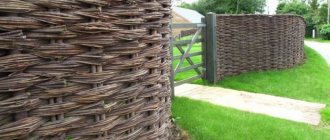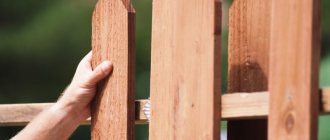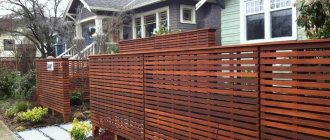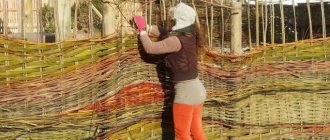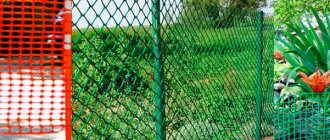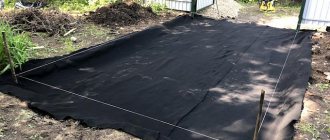A few centuries ago, our ancestors created a reliable and beautiful fence from sharp wooden stakes - a palisade fence. Today, this functional protective structure is again becoming popular in suburban construction. The palisade is an ideal addition to a site with elements of “ethnic” decor or decorated in a “rustic” style. In addition to its decorative appeal, a log fence serves as excellent protection against the encroachments of unwanted guests. Even strong men with extraordinary abilities cannot break such a fence. The palisade is an excellent alternative to traditional concrete, brick or metal protective structures. You can build a stockade in just a few days, but a wooden fence will last for decades.
What is a stockade
This is the name of the fence, which is radically different from existing wooden analogues. It is built from rounded logs sharpened on one side. If you are wondering what “picket fence” means, you should turn to word formation. This word is associated with a series of logs, often driven into the ground. They form a functional enclosing structure that can protect the object from prying eyes, snow drifts and wind.
The palisade is characterized by different heights. This type of fencing looks unusual not only due to the use of pointed logs. If you look at the structure from the outside, you cannot see the pillars. The supporting elements often look like the rest of the beams in the fence row, only they are more deeply buried in the ground. This type of fence can be used in summer cottages for the purpose of fencing country cottages. The design will emphasize the rustic style of the property.
A full-size picket fence is installed around the perimeter of the site. You can also make a small-sized structure that will help zone the territory. The height of the fence is small: from 10 to 50 cm.
Installation
We install the boards in stages. We place 3-4 logs tightly in the ditch, cover them with earth and compact them well. You can water the soil to make it easier to compact, as shown in the video.
After you have completely completed the installation of the fence, it needs to be painted or varnished. This way your picket fence will look aesthetically pleasing, and it will also provide good protection from rain. It is worth noting that even with the best care of wooden products, over time those that are in the ground will begin to rot. You can install the fence on the foundation, as shown in the photo. Then, it will not look so old, and its service life will be longer.
Advantages and disadvantages
A palisade fence is the most original solution, which is important when choosing a fence for an object. Positive qualities of this design:
- a blind type fence creates shade in the summer, and in cold weather protects from wind and snow drifts;
- due to the absence of gaps between the logs, what is happening in the fenced area remains hidden from prying eyes;
- when erecting a palisade, there is no need to build a foundation;
- note the high mechanical strength of the structure;
- the fence is not painted;
- natural materials are used in the construction of the fence;
- simple installation;
- it becomes possible to combine materials, for example, logs and corrugated sheets, boards are used simultaneously, and you can also grow climbing plants along the surface of the palisade.
The fence also has disadvantages. First of all, note the limited scope. For example, a structure of this type is not installed for the purpose of fencing administrative, public, commercial, industrial and commercial facilities. Most often, such fences can be found outside the city or in the private sector. In addition, a stockade is a structure exposed to fire. Its service life is relatively short. This is due to the impact of moisture on the logs.
Types of fences
The design of the fence and materials for its installation are selected according to several parameters:
- Total cost of the fence. When calculating the cost of installing a fence, not only the cost of basic materials is taken into account, but also payment for delivery, unloading, work on installing the fence and removal of construction waste after installation of the fence.
- Design of the entire site. The fence must be in harmony with the buildings located on the site. Fences made of brick or natural stone look better with brick houses. A wooden fence is suitable for a wooden house made of timber.
- Purpose of the fence. A solid high fence not only serves as an insurmountable barrier to thieves and vandals, but is also able to protect your territory from prying eyes.
Blind fences are made of wood, brick, natural stone, and corrugated board. Also, a blind fence can be concrete or made of modern materials - besser blocks or brick elements. Besser blocks are made from a mixture of sand, gravel and cement.
Brick elements are concrete blocks from which you can lay out fence posts, or make the entire fence.
A good option is a combined fence.
Do not forget that a blind fence between summer cottages can only be erected with the permission of the neighbors. By law, you can be forced to remove such a fence - this is unnecessary nerves and a waste of money. Coordinate your plans with your neighbors. It is possible that they not only will not mind, but will also take part of the costs themselves.
Fences made of chain-link mesh, metal and wooden picket fences, and forged cast iron allow light to pass through and allow the area to be ventilated. You can protect yourself from your neighbors with a hedge - this is not against the law.
Material and tool
If you plan to build a palisade fence with your own hands, you need to select logs. To ensure long-term use of the fence, only certain types of material should be used. A structure made from the following types of wood will last longer:
- conifers: pine, spruce, cedar;
- oak;
- alder;
- aspen;
- hazel.
Logs that are identical in appearance are selected. Their diameter can vary greatly: from 70 to 150 mm. If the fence will be used only as a decorative structure, it is permissible to take small logs. When it is important to provide additional protection to an object, wood with the largest cross-section is used.
Dead wood is used for construction. The material can be purchased on the market or prepared independently. The height of the logs is determined taking into account the dimensions of the fence. A fence of 2-2.5 m is installed along the perimeter of the site. In addition, the need to bury the tree in the ground is also taken into account. To determine how deep the fence should be installed, you should choose the method of fixing the material:
- on separate posts and fixed crossbars, then the logs are located above the soil level;
- The products are buried in the ground to a distance sufficient for strong fastening.
In addition to wood, logs and supports may be needed, but these structural elements are prepared if the first of the fence installation methods discussed above was chosen. The following tools are used in the work:
- shovel;
- garden auger;
- building level;
- plumb line;
- axe;
- hammer;
- equipment for wood processing (needed if the material will be prepared by hand).
Decorating the tyn
It is not necessary to paint the tint immediately after installation. The fence will look very impressive anyway. You should think about painting only when the wood has aged.
You can decorate a picket fence in different ways. The choice depends only on your imagination. Many fenced property owners turn stakes into crayons.
Photo No. 7: decorative tint, stylized as colored pencils
Perhaps you will like this decor option too.
Wood processing
Log fences are erected only using bark-free and processed material. To make the fence resemble a picket fence, on one side the shape of the product is changed. You need to get a point; for this, the wood is cut at an angle of 30-40°. It is important to protect the palisade from moisture and insects. Therefore, the lower part of the logs and the small protruding part should be treated with hot bitumen.
Previously, natural material was processed using a more primitive method - the wood was charred on the side that would sink into the soil. A layer of ash on the surface of the wood protects the material well from negative external factors. If you skip this stage, the material will quickly lose its properties and attractiveness. In the worst case scenario, the fence will fall apart in a few years. Treatment using the methods described above will extend the service life of the fence by 10-15 years.
Final coating
The naturally installed fence of stakes needs to be treated. It will be enough to cover pre-impregnated logs with two layers of stain and protective varnish. Manufacturers of relevant materials offer a wide range of products to create a certain decorative effect and protect against negative factors. If the fence is temporary, for example, separating a construction site, then you can do without processing.
Repeated treatment should be carried out as the coating wears out. In this case, the frequency is up to the varnish manufacturers. This also means that it is better to use high-quality coatings, because painting a fence once every 8 years with a good stain is more economical than once every 2 years with a mediocre one.
Thus, it will not be difficult to design, calculate and build a modern stockade yourself if you have the funds and a couple of free days.
How to make a stockade
There are several technologies for constructing a fence of this type. You can consider the traditional option. In this case, the palisade fence is erected without additional tools and materials. Only timber is used. However, this is a long and labor-intensive process, so it has been gradually improved. Today, when arranging a palisade, a trench is first prepared. To increase the efficiency of fluid removal from the structure, drainage is used.
There is a more reliable method - on a columnar foundation. In this case, wooden/concrete/metal pillars are buried in the soil. Crossbars are attached to them, then the logs are installed. When choosing a modern method of building a palisade, they combine materials. However, the fence sheet always remains solid, without gaps, and consists of processed logs.
Traditional
This is an ancient technology for fencing construction. In this case, there is no need to prepare a foundation or even dig holes to install pillars. Log fences are built sequentially. The work is carried out with each individual wooden product in turn. The main feature of this technology is the need to grind both sides of the logs.
The product is inserted into the soil with the tip down, then pulled out. A depression is formed, which is filled with water. The log is again placed at the same point, screwing it in. These steps are repeated until the product is buried to the required depth. The work is labor-intensive, which means that one log during the construction of a palisade will take a lot of time. If you take into account that the material is placed without gaps, the installation will take a long time.
You can speed up the construction of the palisade a little. A heavy hammer is used for this. However, if you have no experience, it is better to refrain from such actions, as the product may become deformed. The hammer should be covered with a protective cap made of material that is resistant to mechanical stress (rubber, polymers).
Modern
A picket fence can be built faster. To do this, it is recommended to prepare a trench. Its width and depth are determined based on the dimensions of the material (depth of wood and diameter of products). In most cases, when building fences and palisades, the supporting elements are inserted into the soil to a level corresponding to 1/3 of the length of the product.
A crushed stone cushion is installed at the bottom. This is necessary to enhance the outflow of moisture from the area where the palisade is located. Then wooden products are installed in the trench; it is recommended to fix each post with spacers. Thanks to this, it will be possible to complete the installation faster by installing several logs at once. They should be located close to each other. Then the fence will look like a picket fence.
The position of each log is checked with a building level and plumb line. It is important to deepen them so that the result is an even, continuous line, and the structure is the same height along the entire length of the palisade. At the next stage, soil is backfilled into the trench. This must be done correctly: the earth is compacted and periodically watered, which will allow the soil to be more compacted. The structure is strengthened by means of logs: wooden crossbars are fastened across the fence, they are placed at a distance of 20 cm from the top and bottom edges.
Today, another option for installing a palisade is common. In this case, the pillars are installed first. They can be made of wood or metal. The last option is strengthened with a columnar foundation. The supports are installed at a distance of 2.5-3 m. Then the logs are attached in any convenient way (welding, nails, screws). Logs or edged boards with a rounding on one side are placed closely on them. This method allows you to create a durable decorative fence that will last a long time due to its reliable fixation in the soil using concrete.
